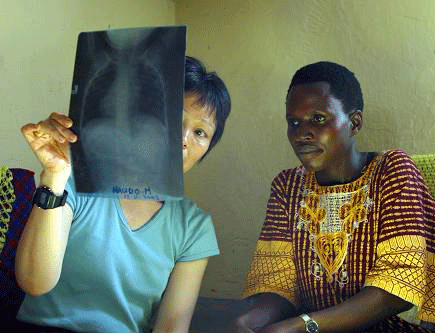Refugee Health Guidelines
Guidelines for pre-departure and post-arrival medical screening and treatment of U.S.-bound refugees

Woman showing patient chest x-ray
Many health conditions may affect the health of refugees; therefore, CDC provides guidelines for health-care providers who may see refugees at any point during the resettlement process. These guidelines aim to:
- promote and improve the health of the refugee
- prevent disease
- familiarize refugees with the U.S. health-care system
There are two major categories of the refugee health guidelines—overseas and domestic.
- The overseas medical screening guidelines are intended to provide panel physicians guidance on the overseas pre-departure presumptive treatments for malaria and intestinal parasites. These screenings are usually conducted days to weeks before the refugee departs from his or her country of asylum.
- The domestic medical screening guidelines are provided for state public health departments and medical providers in the United States who conduct the initial medical screening for refugees. These screenings are usually conducted 30-90 days post-arrival in the United States.
All the guidelines are based on current medical knowledge and the advice of experts in refugee health. Both domestic and overseas medical screening guidelines are to provide healthcare providers with currently accepted best practices, but should not be considered mandates. New guidelines, and revisions to current guidelines, will be posted on this website as more data become available.
The CDC Technical Instructions should not be confused with the domestic or overseas guidelines. Technical Instructions focus on the required medical screening of refugees and immigrants for diseases of public health significance, such as tuberculosis, in accordance with US immigration law. The Technical Instructions are meant to be used by panel physicians who perform the overseas screening and civil surgeons in the US who conduct the medical exams for adjustment of visa status.
Overseas Guidelines
Domestic Guidelines
The Guidelines for the U.S. Domestic Medical Examination for Newly Arriving Refugees aid State programs and medical providers in the post-arrival medical screening for refugees. More »
Overseas Interventions
Medical Screening of Asylees
Asylees are persons who meet the definition of a refugee but are already in the United States or are seeking admission at a US port of entry. From 2000 to 2010, the top ten countries of origin for people granted asylum in the United States were China, Colombia, Haiti, India, Ethiopia, Iraq, Armenia, Albania, Iran, and Somalia. Those who are living in the United States or are seeking admission at a US port of entry when they apply for asylum are recommended to have a domestic medical exam once they have been granted asylum status. When an asylee applies for adjustment of status, an I-693 medical examination (including vaccinations) by a civil surgeon is required. Once an asylee has been granted asylum status, their family members may follow to join them in the US, and therefore these family members would undergo the required medical examination overseas, prior to immigration.
Currently, there are very little data available about the health problems of asylees after they migrate to the United States. Many asylum seekers originate in, or transfer through, countries with public health issues similar to those facing refugees arriving through the US Refugee Admissions Program. Therefore we recommend that medical providers screening asylees apply the same screening and treatment recommendations in the CDC Refugee Domestic Guidelines when performing a medical evaluation of an asylee. For individuals who have been in the United States for more than one year, special attention should be paid to diseases with long latency and associated severe morbidity such as tuberculosis, hepatitis B, and Strongyloides infection.
- Page last reviewed: March 29, 2012
- Page last updated: November 12, 2013
- Content source:


 ShareCompartir
ShareCompartir